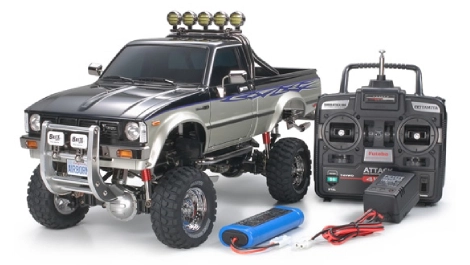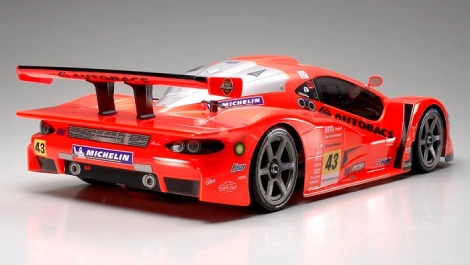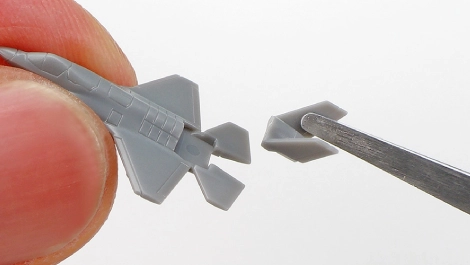Mini 4WD Machine Setting Guide
Introducing basic knowledge that will make mini 4WD settings more fun if you know them!
Even if you say "make the mini 4WD faster", there are various seasonings of the machine, such as a machine that is fast in corners and a machine that is fast on the straights, depending on the course and strategy. On this page, for those who are about to take on the challenge of mini 4WD, we will introduce basic knowledge that will be useful for machine settings and customization.
- A must-see for those who use screwdrivers and nippers for the first time!
- Check out the key points of mini 4WD settings on Youtube
- The speed of the machine is controlled by changing the motor
- The axis of the rotating part is smooth.
- Tires with good grip are not always faster?
- Jumps are controlled by brakes and mass dampers
- Light is justice! But...?
- Roller position and machine width are key
- Find the ideal gear ratio for your course
- We recommend starting with a beginner's set.
- Check out the parts that can be used for your car
- Functional upgrade parts & machine links
A must-see for those who use screwdrivers and nippers for the first time!
Let's Assemble the Mini 4WD / MA Chassis We will carefully introduce how to assemble the mini 4WD from the initial preparation to the completion of the machine, such as how to use the screwdriver and nippers. Please refer to it when creating your first machine.
Check out the key points of mini 4WD settings on Youtube
The important points of the setting are explained on Youtube for each item. Please also see here.

The speed of the machine is controlled by changing the motor
There are various types of motors, such as acceleration-oriented, top-speed, and average, and replacing them will significantly change the characteristics of the machine. One rule of thumb is to focus on acceleration on courses with many uphills and corners, and emphasis on maximum speed on courses with many straight lines, but which motor is best depends on the course. Regardless of which type you choose, replacing the motor from the stock motor will make the machine faster, but it will also increase the cornering speed, so if the parts other than the motor remain standard in the kit, the probability of going off the course will increase significantly. When changing the motor, it is essential to improve the performance of the entire machine accordingly.
Tune even more finely by changing gears!
Useful for more detailed tuning is a gear set for setting. Adjust the motor that emphasizes acceleration to focus on the maximum speed a little, or make the motor that emphasizes the maximum speed a little more focused on acceleration ... By combining it with a motor, you can enjoy subtle tuning according to the course.
Even more detailed with the "size" of tires & wheels!
Even with the same motor and gear settings, you can adjust the "wheel diameter" to focus on acceleration by decreasing it, and by increasing it with a higher weight, you can adjust it to focus on maximum speed. Furthermore, if the tires are thinner, the emphasis is on acceleration, and if the tires are thicker, the maximum speed is emphasized. Motor type + gear + wheel diameter + tire diameter. Combine them well and find the perfect setting for your course!

The axis of the rotating part is smooth.
By maintaining the parts that rotate, such as the bearings and gears of rollers and shafts, so that they move smoothly (less frictional resistance), the maximum speed, acceleration, cornering speed, and even running time are improved. The basis for reducing frictional resistance is to carefully grease up as shown in the explanatory diagram. In addition, debris may adhere to the vehicle while driving, so it is important to clean and grease it regularly. However, if you apply too much grease, it will become a resistance in itself, so be careful not to apply too much. In addition, it is more effective to use a high-performance grease such as a smooth "Mini 4WD F grease (containing fluororesin)" or an oil pen than the grease that comes with the kit!
Smooth with the introduction of bearings!
If you are aiming for a smoother machine, you may want to consider using bearings for the bearing part, which causes a lot of friction. Bearings that can be used for each part, such as gears, bearings, and rollers with bearings, are available, and by replacing them, frictional resistance can be greatly reduced.
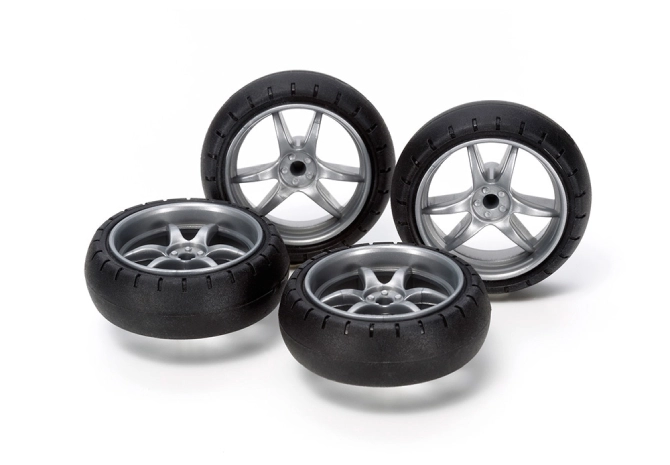
Tires with good grip are not always faster?
Tires with good grip are not always faster?
In actual car racing, the grip performance of tires is important, but from a different perspective, soft tires that grip are tires with high frictional resistance. In the MINI 4WD, soft tires cause more friction with the road surface when cornering, which reduces cornering speed. However, it is also true that cornering stabilizes when the speed decreases. Do you want to glide through corners with hard tires, or do you want to focus on stability with soft tires? In addition, do you want to align the front, rear, left and right tires, or change each of them? The best setting will change depending on the course!
The grip changes even with the width of the tire!
Not only softness but also width is important. Even with the same tire, the frictional resistance decreases as the width of the tire (the part that comes into contact with the road surface) becomes thinner. A tire with a round contact patch, such as a barrel tire, may look wide, but there is only a small part that comes into contact with the road surface. As a result, there is very little loss of speed in corners.
In addition, the grip changes depending on the distance between the left and right tires!
When the distance between the left and right tires (tread) becomes wider, the frictional resistance during cornering increases due to the influence of the inner wheel difference, resulting in a more stability-oriented setting (speed reduction during cornering). Offset tread tires are unique tires that allow you to adjust the tread width depending on the orientation in which they are mounted. When used in conjunction with a barrel tire, it is possible to set three types of tread widths: inside, middle (barrel tire), and outside.
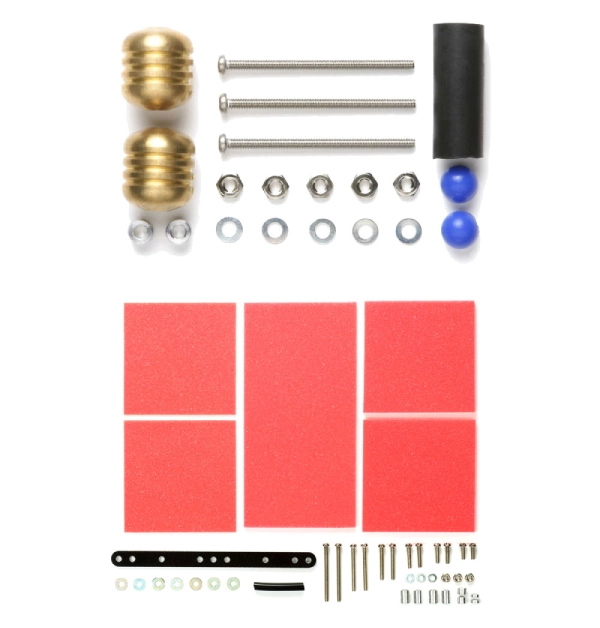
Jumps are controlled by brakes and mass dampers
If the machine gets faster, the distance may be too high in the jump section and it may go off course. Helping to prevent this is the "brake unit" and the "mass damper". In the case of the brake unit, by adjusting the slippage of the sponge in contact with the road surface, the number (area) to be installed, and the height, etc., the speed before the jump can be controlled, and the flight distance and flight attitude can be controlled. And the impact of landing after jumping is controlled by the mounting position and weight (number of installations) of the "mass damper". Do you want weak brakes and lightweight dampers that can barely clear the course, or strong brakes and weight dampers that put safety first? Even if you can clear the course safely, what if your rival takes a risk and sets up a speed-oriented setting? It is important to set up the course according to the competition and the competition!
The best landing form depends on the course and the machine!
The basic principle of landing is to land in a state where you can accelerate immediately. If the car bounces after landing, it will slow down the acceleration and lead to time loss. Be careful when landing forward on an uphill slope or on a downhill slope, as the machine tends to bounce without absorbing the shock even with a mass damper.
Determine which sections are the most important and set them up!
If your course has multiple jump sections and the landing points are flat, uphill, and downhill, it can be very difficult to get the ideal landing setup for all sections. In such cases, it is essential to determine which sections are most likely to affect your time (e.g., long straights after landing) or which sections are most dangerous (e.g., some sections that will be unstable after landing) and set them accordingly.

Light is justice! But...?
In the world of racing, making the car lighter is important. As the weight of the car is reduced, the burden on the motor is reduced, so if the car has the same motor, a car that is even one gram lighter will have an advantage in terms of acceleration and top speed. Also, when reducing weight, it is important to remember that the position of the center of gravity changes. In general, the lower and more central the center of gravity is, the more stable the car will be. For example, if you compare a car with one that only has a lighter chassis and one that only has a lighter body, the lighter body will have a lower center of gravity and be more stable. When making weight reductions, remember that the basic rule is to "lighten from the top"!
Changing the center of gravity changes the flying posture!
Lightening the weight of the machine changes the center of gravity, but for example, if you lighten just the bonnet of the body, or just the rear area, the flying posture during jumps will also change. Having several bodies with different weights and center of gravity will not only improve the appearance, but also expand the range of settings.

Roller position and machine width are key
Rollers are essential for a Mini 4WD to run smoothly through corners. In official competitions, the number of rollers that can be installed is limited to six, and the way the machine runs changes depending on the selection of these six rollers and where they are installed (as of February 2018, there is no limit to the number of rollers as a special rule). One criterion is whether the machine can stand on its side on the rollers alone. There are many types of rollers, with many different diameters, thicknesses, weights, and grip on the wall (friction resistance), so choose the right one for the course and machine.
The overall width of the machine, including the rollers, must be no more than 105mm!
In official competitions, the overall width of the machine, including the rollers, must be no more than 105mm. If you increase the overall width of the machine by using larger diameter rollers or combining FRP plates, etc., the machine will run on the inside of the course more than in its normal state, and you will be able to reach the finish line in a shorter distance (in other words, it is advantageous to increase the overall width of the machine). However, the corners will be tighter because you will be running on the inside, so don't forget to set it up accordingly!
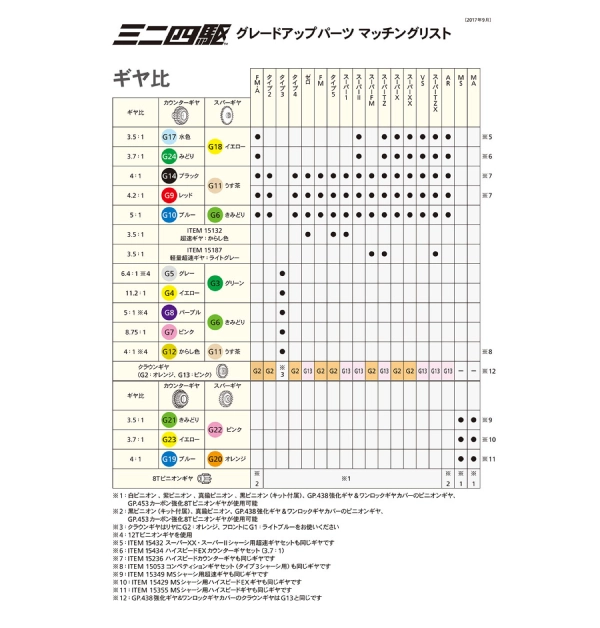
Find the ideal gear ratio for your course
Gear ratios are listed as 5:1, 3.5:1, etc. This number indicates how many rotations the motor needs to rotate the tire once. In other words, it means how many rotations of power the motor uses to rotate the tire once. Between 5:1 and 3.5:1, the 5:1 gear ratio is more powerful because it uses the power of 5 rotations. On the other hand, the 3.5:1 ratio has less power per tire rotation, but the tire rotates many times, so it can go faster. However, the 5:1 ratio, which has more power (torque), is more advantageous in terms of acceleration. If you were to compare this to a bicycle with a gear shifting function, the 3.5:1 would be a "heavy gear" that prioritizes speed. The 5:1 ratio would be a "light gear" that prioritizes power. If the road is flat, the heavier gear will run faster, but it will take longer to reach top speed, and what if there is a steep slope before you can reach speed...? With Mini 4WD, which cannot change gears while driving, it is very important to choose a gear ratio that suits the course.
Pursuing top speed may result in poor time!
Gear ratios can be changed within the range listed in the matching list, but be careful of compatibility with other upgrade parts! Combining a speed-oriented gear ratio with a speed-oriented motor will give you a high theoretical top speed, but on courses with short straights, you may not be able to reach top speed, or you may only reach it for a moment. In some cases, a power-oriented gear ratio may be better in terms of total time, as it has a lower top speed but is less likely to stall in corners and is easier to maintain top speed. The best gear ratio depends not only on the motor and course layout, but also on the weight of the machine and the diameter of the tires. Prepare a full set of gears and research the ideal set to suit your course!
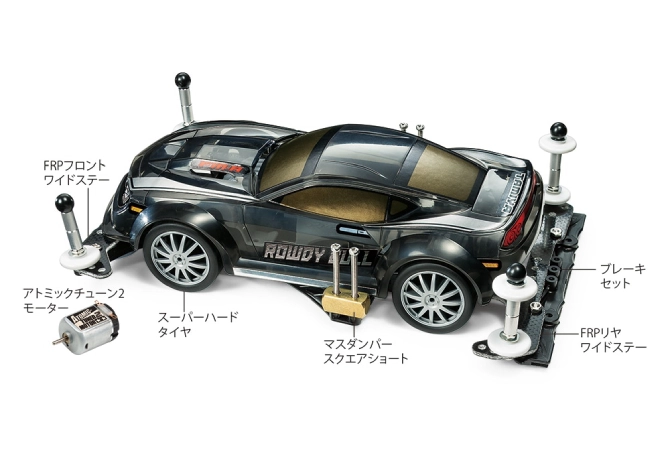
We recommend starting with a beginner's set.
As we've seen, the appeal of Mini 4WD is the variety of settings you can enjoy, but if you don't know where to start, don't worry! There is also an item called the "Starter Pack" that comes with a Mini 4WD and basic upgrade parts such as a high-performance motor, rollers, stays, mass dampers, and brake units. There is also a "First Try Parts Set" that comes with basic upgrade parts such as rollers and mass dampers, and if you purchase it together with your favorite machine, you will be ready to take on the challenge of circuit racing right away. We recommend using these set items to make your debut!
View First Try Parts Set , Perfect for your debut! "Starter Pack"

Check out the parts that can be used for your car
There are many chassis available for racing Mini 4WDs, including the traditional rear motor chassis that has been around since the days of the Mini 4WD racers, the front motor chassis with a forward center of gravity, and the chassis with a midship layout and double shaft motor. When purchasing upgrade parts, don't forget to check if they are compatible with the chassis you are using. In addition to explaining each chassis, the Chassis Select Guide also lets you check which parts and machines are compatible with each type of chassis, so be sure to check it out!


